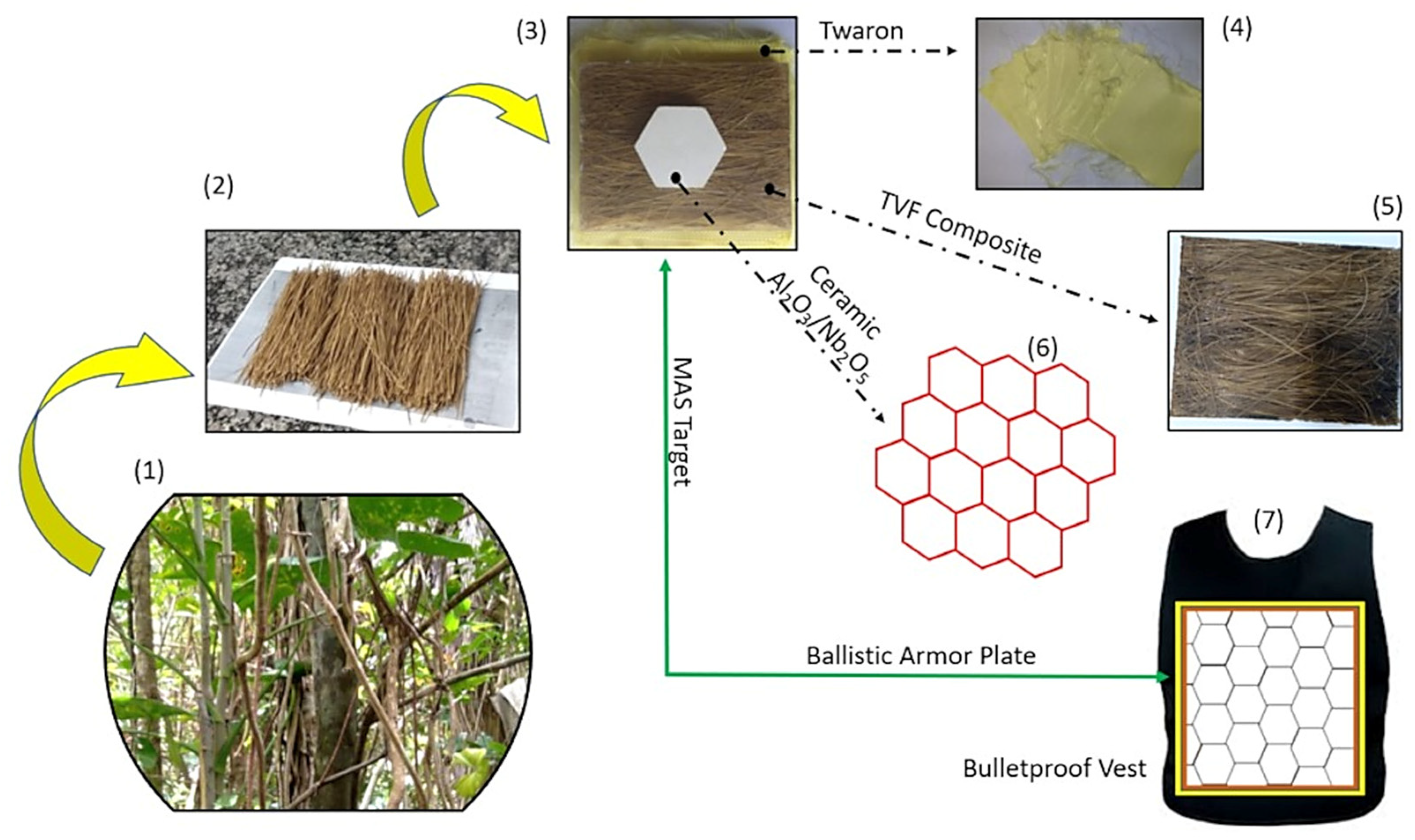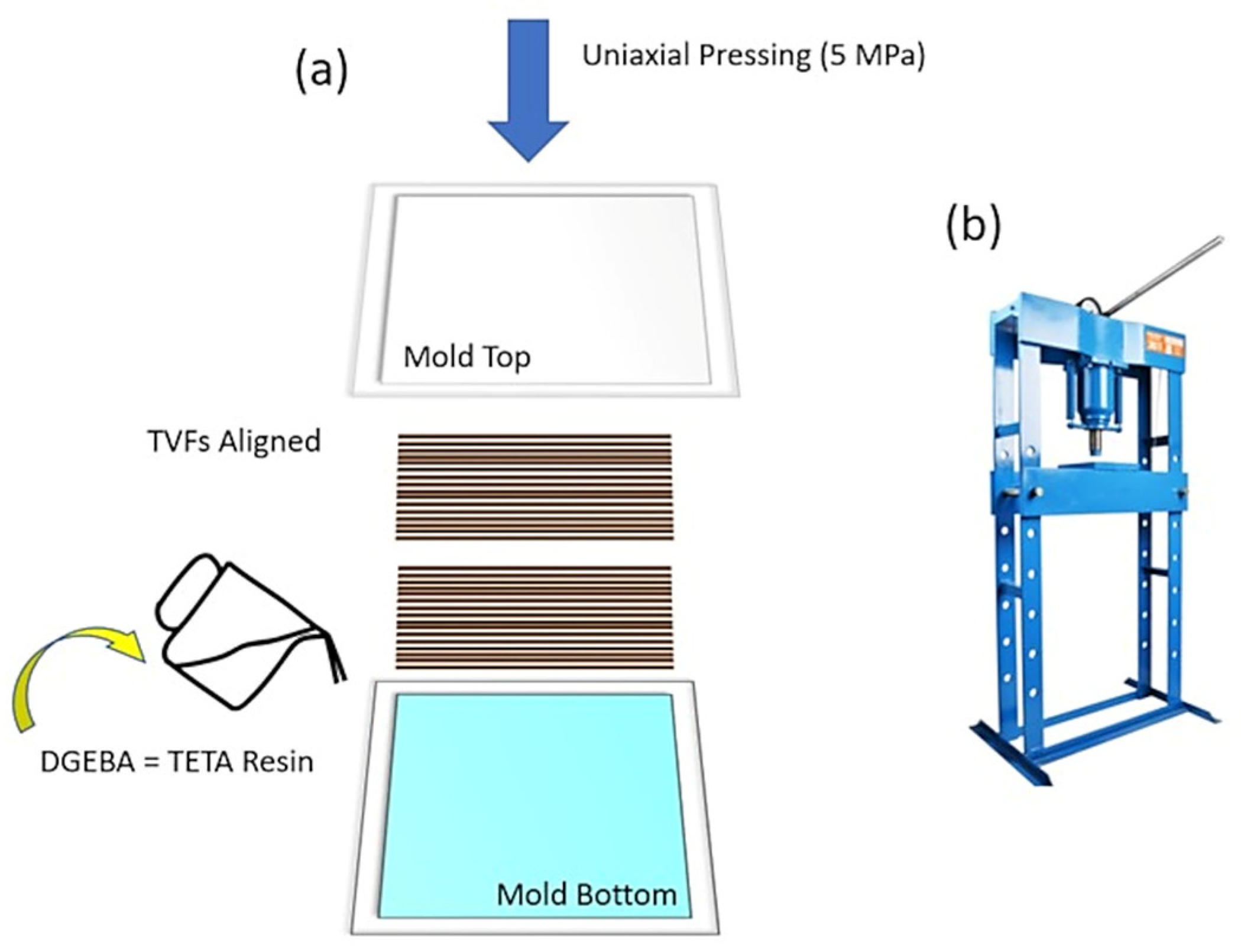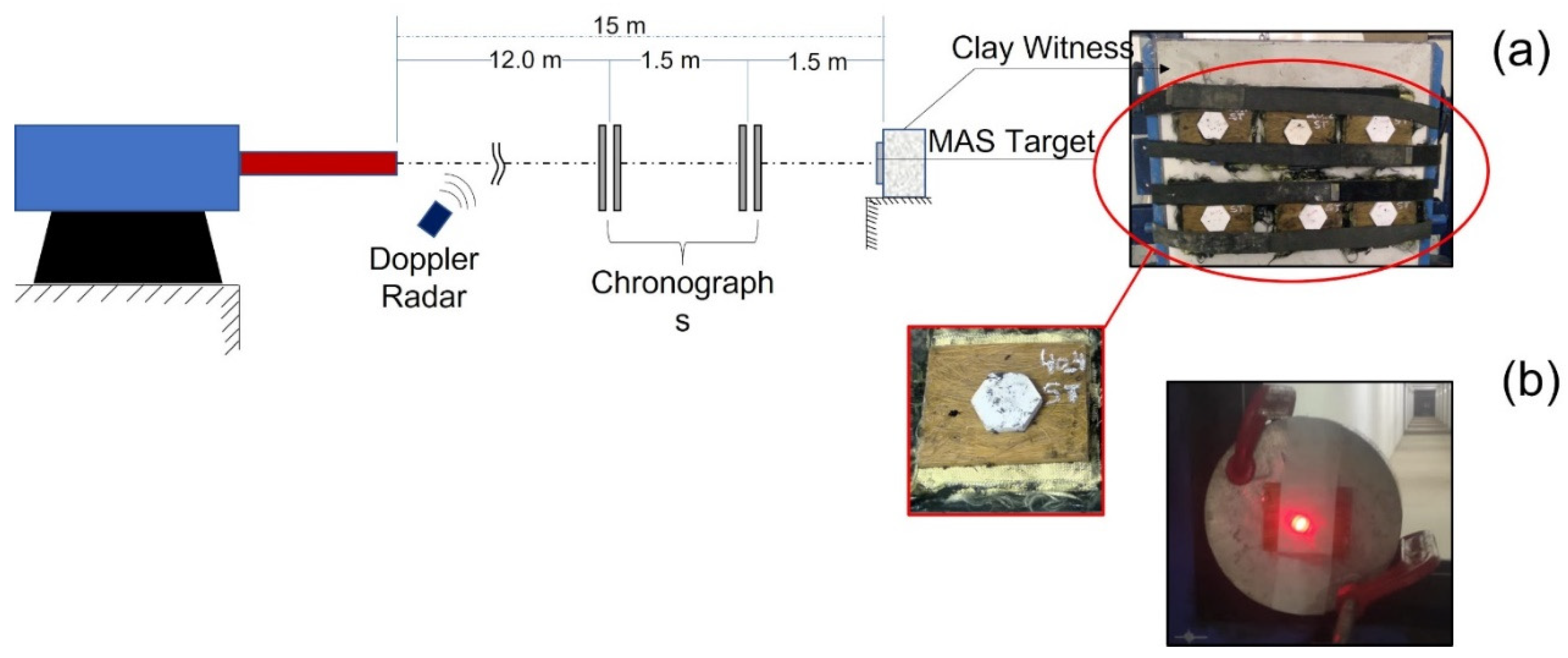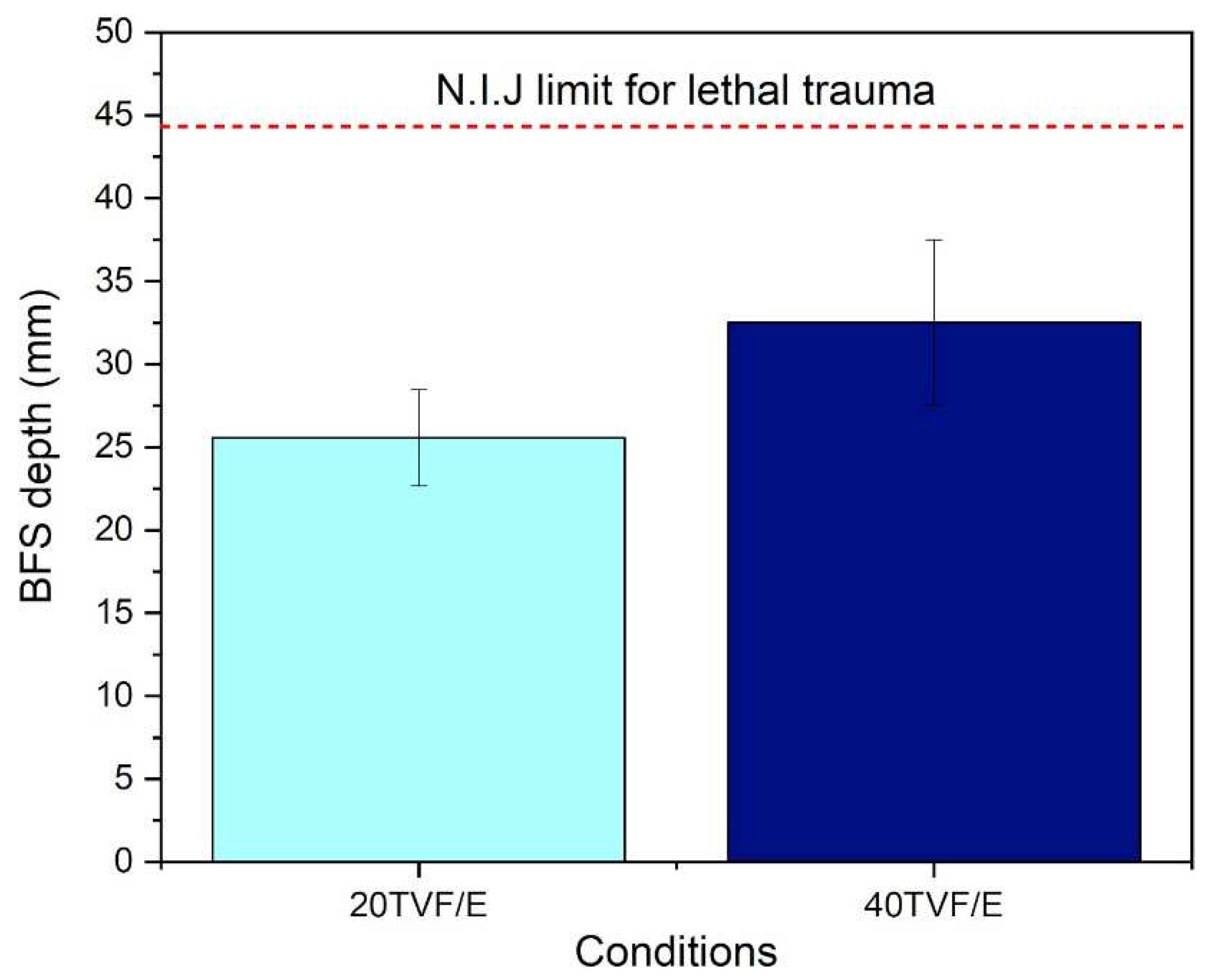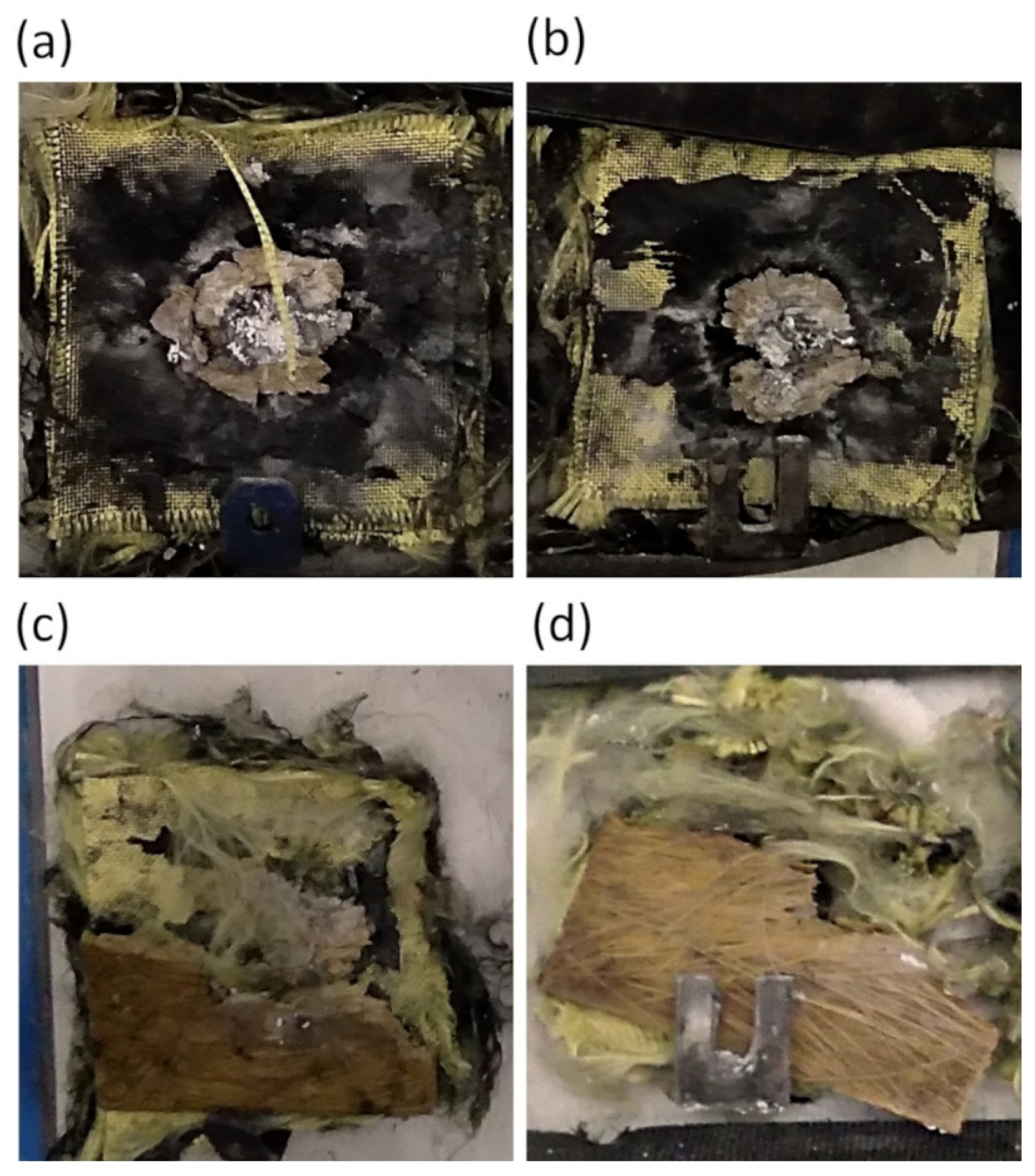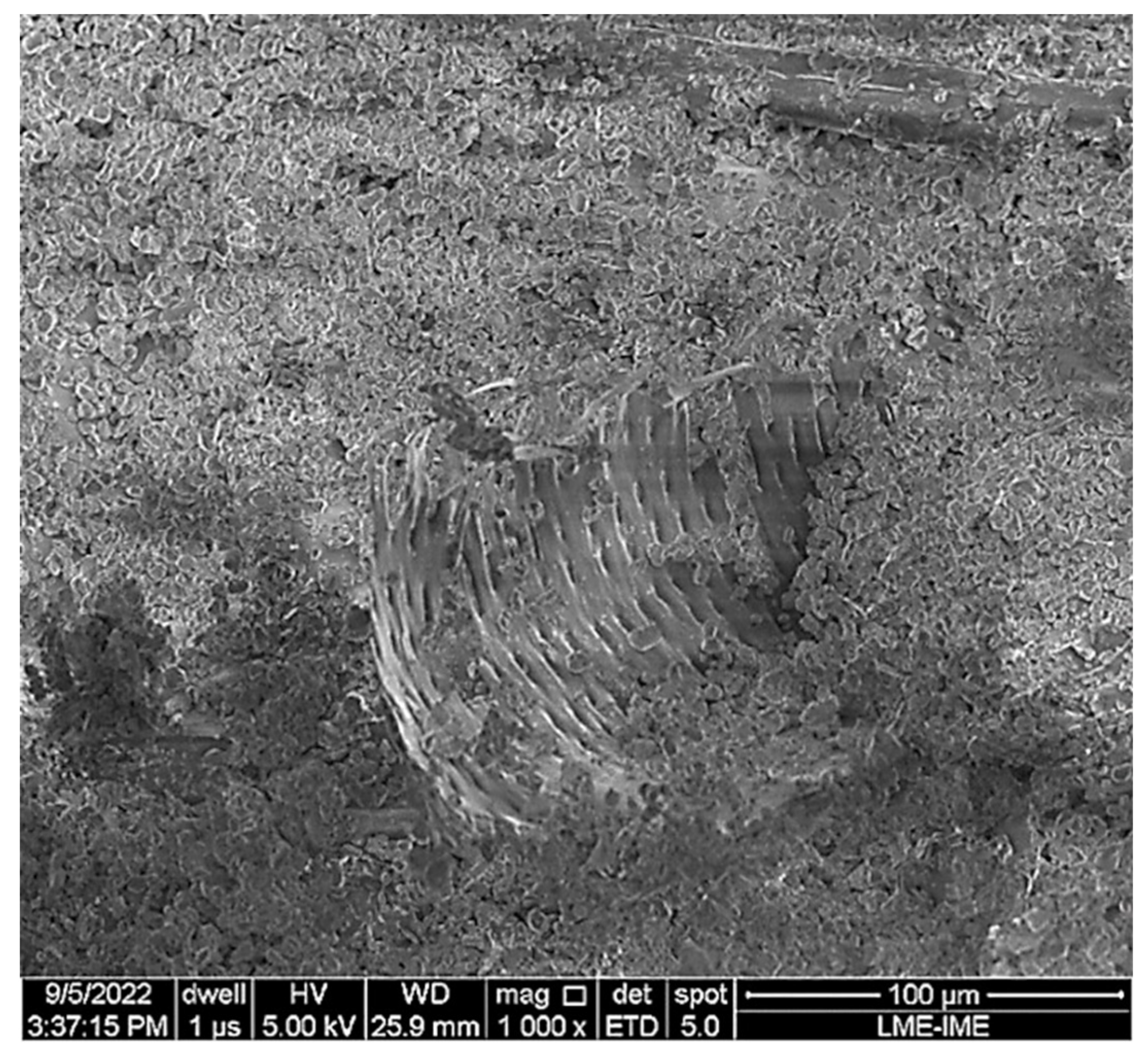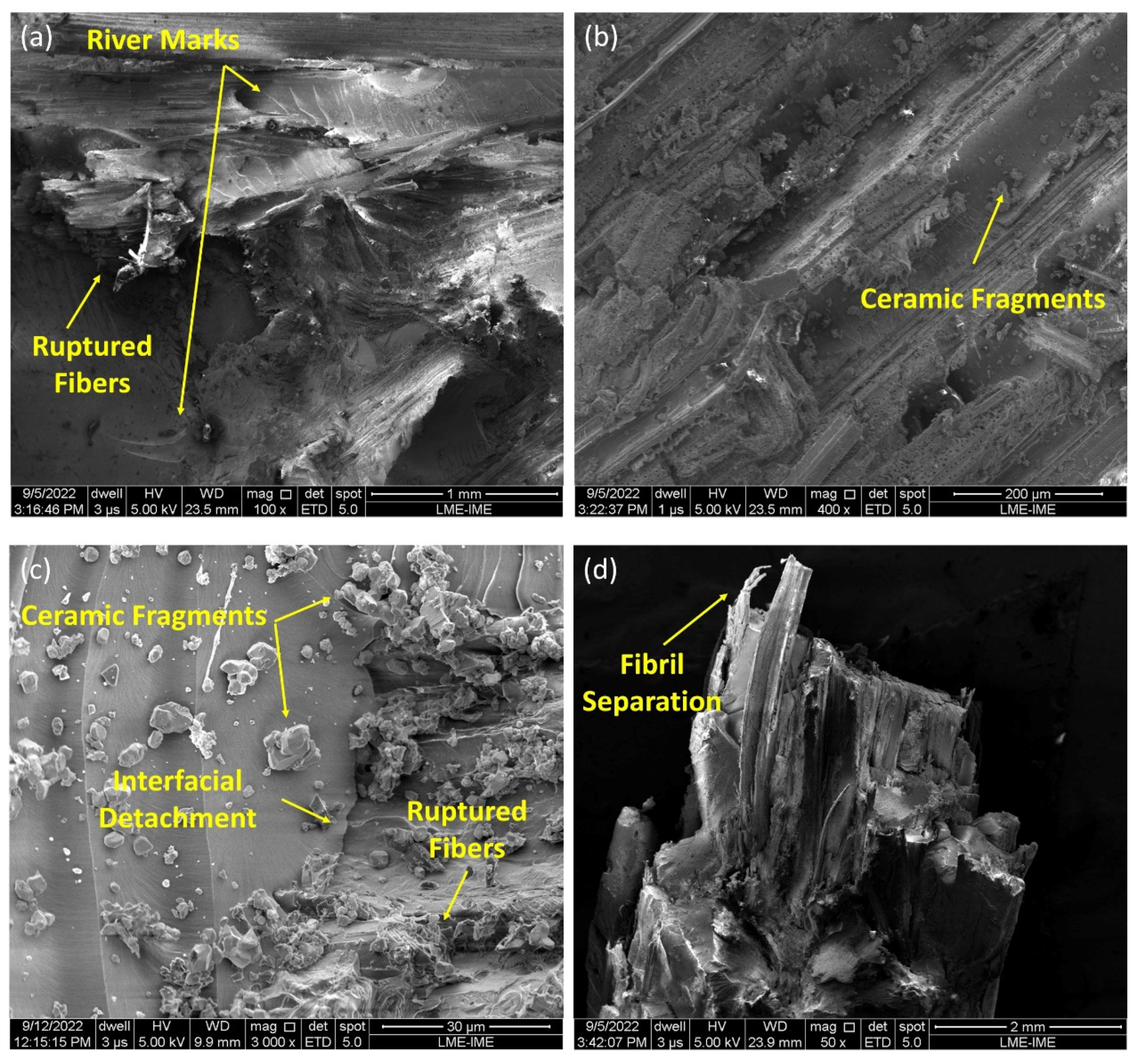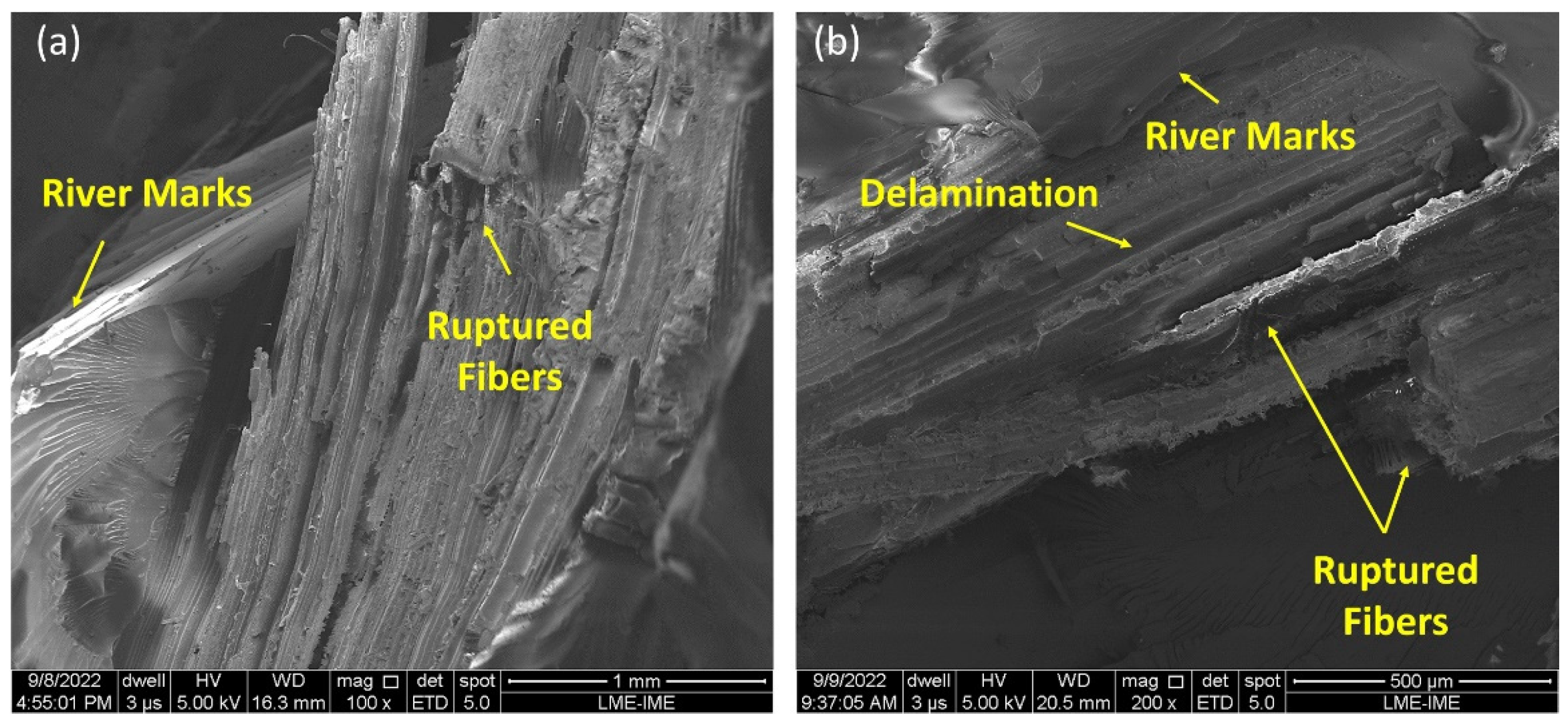3.1. Multilayered Armor System (MAS)
Previous studies [
44] confirm the efficiency of MASs consisting of three layers (ceramic + NLFs composite + aluminum alloy) protect against level III ammunition and meet the BFS depth criteria established by the NIJ [
14]. However, in the present work, armor plates were placed in front of target samples that simulate a level IIIA bulletproof vest to enhance its performance to level III protection against 7.62 mm ammunition. The results obtained for the MASs tested in this study are shown in
Figure 4. The systems in which the intermediate composite plates have 20 and 40 vol% TVFs were denominated 20TVF/E and 40TVF/E, respectively.
For all samples and conditions tested there was no complete perforation of the target. In addition, for both groups, the BFS depth was less than 44 mm, the maximum limit allowed by the NIJ [
14] to avoid lethal trauma. With the increase in the volume of fibers present in the second layer, the measured trauma increased from 25.57 mm to 32.51 mm. This same behavior was reported by other authors. Oliveira et al. [
45] investigated the ballistic performance of both single composites of fique fabric and epoxy and their application as an intermediate layer in MASs. In their work, an increase in the BFS depth of 3.3 mm was verified when incorporating larger fractions of fique fabric (15 to 50 vol%). Demosthenes et al. [
46] verified that as buriti fabrics volume content was increased in epoxy matrix composites, there was a gradual increase in the traumas measured in the clay witness, jumping from 18.9 mm for the 10% samples to 25 mm for those with 30 vol%. This behavior is probably associated with transitions in the fracture mechanisms acting on the composites, which were evaluated by means of SEM and further discussed in a following separate section.
The Weibull distribution was used to quantify the statistical reliability of the measured BFS depth results.
Table 2 presents the distribution parameters related to the evaluated property (BFS depth), were β the Weibull modulus, θ the scale parameter, and R² of statistical precision.
Table 2 shows that the 40TVF/E composite had a lower β value, indicating a greater dispersion of values, as confirmed by the higher standard deviation of this group. The θ parameter followed the expected trend, correlating with the BFS depth measured in the test. Specifically, 62.3% of the tested samples in the 20TVF/E and 40TVF/E groups had a BFS depth of approximately 26.9 and 34.7 mm, respectively. The statistical precision coefficient R
2 was highly representative and within an acceptable reliability range (>0.83). However, up to 17% of the samples in the 20TVF/E group and 4.5% in the 40TVF/E group could not be explained by the Weibull mathematical model.
Although the BFS depth increased with the volumetric fraction of TVFs, the standard deviations for the average measurements extracted from these groups may conceal the correlation regarding possible differences between the composites. To clarify this, ANOVA was performed on the results shown in
Figure 4. The results indicate, with 95% confidence, that the values are different, as F
calc = 7.28 > F
critical = 5.31. Therefore, since there are only two sample conditions, it is possible to say that the volumetric fraction of fibers incorporated into the composites influenced the increase in the BFS depth exhibited by the MASs samples, with systems with 20TVF/E resisting the penetration of the projectiles better.
Figure 5 depicts the appearance of the MAS target after being hit by a 7.62 mm projectile in ballistics tests using 20TVF/E and 40TVF/E as an intermediate layer.
In all samples the ceramic plate was completely destroyed (
Figure 5). This occurs because this material is responsible for absorbing most of the impact energy [
9]. Despite this, the composite layer plays a fundamental role in energy dissipation through the capture of ceramic fragments [
19,
47] that can be visualized by the presence of small white particles covering the fracture surface in the central area. This will be better explored by SEM images.
The ballistic tests showed that even though the MAS samples with an intermediate layer of 20TVF/E presented greater resistance to penetration due to their smaller BFS depth, the plates of this condition were almost completely fragmented, as seen in
Figure 5a,b. In contrast, the targets with 40TVF/E showed traces of composite fragments stick to the shield, indicating an improvement in the physical integrity of the material with an increase in fiber content, as shown in
Figure 5c,d. This improvement in physical integrity is an important criterion for ballistic applications, as noted by Monteiro et al. [
48].
The SEM image illustrated in
Figure 6 shows the surface of a 20TVF/E composite covered by ceramic material. Note that the intermediate layer absorbed the kinetic energy of the fragments through mechanical encrustation. This is due to electrostatic charges and van der Walls forces acting on the surface of the composite [
11].
To better understand the fracture and energy absorption mechanisms at work, SEM images were taken on the surface of the target samples after the 7.62 mm shootings, as shown in
Figure 7.
The performance of the target MASs can be explained through an evaluation of the fracture surface of these samples.
Figure 7a,b confirms the brittle fracture tendency of the 20TVF/E composites. Although mechanisms of fracture and energy dissipation are observed, such as TVFs rupture and capture of ceramic fragments, the micrographs point to the strong influence of the epoxy resin which is predominant throughout the composite. In addition, there is a significant presence of river marks.
When checking the images in
Figure 7c,d, mechanisms similar to those evidenced in the 20TVF/E samples are also present. However, others can still be identified, such as interfacial detachment and fibril separation. These same mechanisms of energy dissipation were reported by Costa et al. [
12] when evaluating the ballistic performance of epoxy composites reinforced with curaua fibers.
The 40TVF/E samples exhibited more complex mechanisms due to the action of TVFs, as evidenced by a more disturbed fracture surface and better physical integrity. However, the greater BFS depth after impact on the MASs samples with larger fiber volumes suggests these mechanisms were not sufficient to improve the ballistic behavior. This could be attributed to the weak compatibilization at the TVF/E interface, which is often associated with the hydrophobic nature of the matrix and the hydrophilic nature of the fibers. Additionally, the presence of impurities on the surface of the TVFs such as waxes and oils can make it difficult to anchor with the matrix. Furthermore, the fibers have lower mechanical properties compared to the epoxy resin, which has a tensile strength of 38 MPa and an elastic modulus of 1.38 GPa [
30]., whereas TVFs have 26 MPa and 1.02 GPa, respectively, as described elsewhere [
49].
Table 3 compares the materials used as an intermediate layer in MAS available in the literature and those investigated in the current work.
According to the data presented in
Table 3, it is observed that the results of the composites with 20 vol% of TVFs are similar to those obtained using NLFs traditionally known as buriti and coir reinforcing the intermediate layer of MASs. Increasing the TVF fraction to 40 vol% leads to BFS depth measurements closer to those obtained with 30 vol% of coir and guaruman fibers, indicating that higher TVF fractions are more effective in enhancing ballistic performance. Interestingly, the MASs with 40TVF/E exhibit superior ballistic performance compared to those with bagasse/E (at a lower fraction) and a Dyneema plate. It should be noted that the systems with bagasse and coconut fibers used an aluminum plate (ρ
al=2.66 g/cm
3) [
50] as the third layer, while in this study, 12 sheets of Twaron fabric (ρ
Twaron= 1.44 g/cm
3) [
51] were used, resulting in a lighter and more mobile individual.
3.2. Stand-Alone Ballistic Tests
Table 4 presents the results of impact velocity (V
i) and residual velocity (V
r) that enabled the calculations of the absorbed ballistic impact energy (E
abs) and limit velocity (V
L), according to Equations 1 and 2, for the stand-alone tests with 7.62 mm ammunition.
From the values calculated for E
abs and V
L, the Weibull distribution was performed to determine the degree of dispersion and the level of precision associated with the ballistic results obtained, as shown in
Table 5.
Based on the results shown in
Table 4 and
Table 5, higher values of E
abs and V
L can be noted for the 0TVF/E (plain epoxy) condition. In general, the data show a downward trend as the content of TVFs increases in the composite. This behavior can be explained by the brittle characteristic of the epoxy matrix, which tends to dissipate energy by generating fracture surfaces [
52,
53]. Garcia Filho et al. [
53] noticed a decrease of 80J in the energy absorbed by the 40 vol% compared to the 10 vol% fiber-reinforced composites, when investigating the ballistic potential of epoxy composites with piassava fibers. Similarly, Pereira et al. [
54] reported in their research the same decrease trend with the increase of the volumetric fraction of fique fibers and fabric inserted in a polyester matrix.
According to the Weibull distribution, it is possible to infer that out of the seven (7) samples tested for each condition, four (4) will present Eabs and VL with values close to the θ calculated for their respective group. Additionally, the 20TVF/E group stands out as the least homogeneous of all the conditions evaluated. This can be better explained by the low β obtained, which characterizes a less narrow distribution, i.e., with little repeatability of the results. It is suggested that this fact is related to processing defects, such as the presence of voids and bubbles acting as stress concentrators and faults. In addition, the R2 correlation coefficient showed good adjustment (> 0.85), therefore demonstrating high data accuracy.
According to
Table 6, in view of the results of the ANOVA of the absorbed energy and limit velocity, it can be stated with a confidence level of 95% that the results are statistically different, since F
cal > F
critical.
To determine the significance of the differences in mean values between the treatments, a Tukey test was performed, and the results are presented in
Table 7. With 5 treatments and 30 degrees of freedom, the studentized amplitude (q) was calculated to be 4.1. From this, an honestly significant difference (HSD) of 34.62 J for absorbed E
abs and 19.71 m/s for V
L was determined. The mean values that are significantly different from the others are highlighted in
Table 7.
The comparison between the averages presented in
Table 7 indicates that plain epoxy demonstrated the best performance in terms of energy absorption compared to the other conditions. The composites with 10 vol% were statistically equal to those with 20 and 30 vol% since the calculated difference between the means was smaller than the HSD. Formulations with 0, 10, 20 and 30 vol% were found to be statistically different from the 40 vol% condition. This explains the higher mean values calculated for the latter and the sharp decrease in absorbed energy observed in
Table 4. In terms of V
L, the comparison between the averages shows a similar trend.
Once again, the physical integrity of the materials must be considered. If on the one hand, the plain epoxy and samples with higher epoxy matrix percentages showed higher E
abs and V
L values, on the other, they either shattered completely or had long cracks propagating throughout, corrupting their physical integrity. In contrast, increasing the content of TVFs managed to contain such problems. In fact, materials for ballistic shielding application should not be destroyed after the first shot but must be able to support other impacts and continue to dissipate energy after several shots. Used as an intermediate layer in a MASs, a plain epoxy plate would not reach this requirement.
Figure 8 presents composite plates with 0, 10, 20, 30 and 40 vol% of TVFs after the ballistic impact of a 7.62 mm projectile.
Analysis of the post impact aspects shows the complete fragmentation of the plain epoxy plate (
Figure 8a). After incorporating a small amount of TVFs (10 vol%) this effect is attenuated, but partial fragmentation of materials is still observed (
Figure 8b). When inserting 20 vol% of fibers, the composite has greater dimensional stability compared to the two previous conditions. However, it is possible to notice the presence of cracks that propagated from end to end in the material (
Figure 8c). For condition 30TVF/E, the samples display smaller cracks and its propagation interrupted due to the greater performance of TVFs (
Figure 8d). The group that stood out in terms of physical integrity was 40TVF/E (
Figure 8e). In the tests test of this condition, it can be highlighted only the presence of broken fibers in the region where the shooting occurred, with absence of cracks and deformations on the surface of the material that could be seen macroscopically. Therefore, this condition showed the best potential for ballistic applications as an intermediate layer. Although it did not have the best results of E
abs and V
L, it had its integrity best preserved. In addition, when employed in conjunction with other materials that constitute an MAS, it proved its efficiency by presenting a BFS depth below the limit established by the NIJ standard of 44 mm [
14].
Composite samples of 10, 20, 30 and 40 vol% of TVFs exhibited failure mechanisms that were best verified after fractographic analysis by SEM. The images obtained are illustrated in
Figure 9.
When evaluating the behavior presented by the 10TVF/E and 20TVF/E composites (
Figure 9a,b), several common failure mechanisms are identified. These samples obtained the highest E
abs values after the impact of the projectile, this characteristic being associated with a greater performance of the brittle fracture mechanisms of the epoxy resin. This was evidenced by the strong presence of river marks. Despite this, the discreet action of the fibers can be visualized by the appearance of broken fibers and delamination on the surface of the material. Thus, when considering the post fracture aspects presented by these two groups, it is possible to perceive that the TVFs were not efficient in these fractions, as they did not induce a change in behavior, predominantly brittle fracture, nor the triggering of more complex fracture mechanisms.
When observing
Figure 9c,d, it is noted that the areas close to the occurrence of the shooting became more rugged and with difficult analysis of the mechanisms present. However, the absence of both river marks and the propagation of long cracks on the surface of the material is noticeable. In addition, mechanisms such as pullout, shearing and fiber rupture are more frequent in the micrographs, giving evidence that more complex fracture mechanisms were activated and those that already existed were intensified, despite the fracture mode persisting as brittle.
Even with the inferior ballistic performance of the 30TVF/E and 40TVF/E samples, the action of the TVFs is quite evident in the images, being efficient in the sense of promoting barriers against the propagation of cracks and fissures and, consequently, keeping the integrity of the material. On the other hand, it is inefficient in terms of raising the energy absorbed by the plate.
Table 7 shows a comparison of E
abs and V
L for the TVFs and epoxy composites tested as a stand-alone and previous results available in the literature, in which several natural fibers were used, including when incorporated into polyester resin.
When evaluating the ballistic performance of the TVFs and epoxy composites, it is noticeable that these presented E
abs and V
L values higher than any other composites of polyester matrix, as well as the plates with 30 vol% curaua and epoxy and the aramid fabric, all with the same thickness of 10 mm, as shown in
Table 7. Furthermore, the composites with 20 and/or 30 vol% TVFs are comparable to buriti fabric [
46] and
C. malaccensis fibers [
18], both incorporated in an epoxy matrix. It is worth noting that the composites with buriti fabric and
C. malaccensis fibers showed higher standard deviations compared to those in the present work. Indicating greater homogeneity of samples with TVFs.
The greatest decay of the parameters listed in
Table 7 occurs from samples of 30 vol%. The condition with 40 vol% TVFs exhibited 62 J less compared to piassava in the same fraction of fiber and resin. A portion of this result can be justified by poor fiber/matrix adhesion, pressing with excessive load during sample processing, which may have enabled the generation of microcracks in the material, but mainly, as previously mentioned, to the mechanical properties of TVFs lower than that of the epoxy matrix. Despite this, when applied to MASs, none of the samples underwent total perforation and all showed BFS depth smaller than 44 mm, with the 40TVF/E condition that better maintained the physical integrity of the composite. Therefore, together with the 30TVF/E group it is suggested as the most efficient for applications in ballistic protection.
